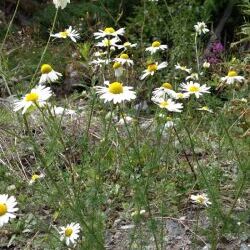
Priority: Contain
General: A daisy with distinct fern-like leaves.
Height: Grows between 5 and 100cm tall.
Flowers: Single daisy flowers growing at the end of each stem.
Leaves/Stems: Stems are smoothed and branched. Leaves are very finely divided, smooth and fern-like, thread-like segments.
Root: Fibrous & extensive.
Scentless mayweed, false chamomile
Invasive oxeye daisy.
Differences: The leaves on Oxeye daisy are very different and variable. Oxeye daisy has spoon and lance-shaped leaves. They can have toothed edges near the top of the stem.
Where did it come from? Introduced from Europe.
Where does it grow here? Grows from low to mid-elevations in BC. It is found in disturbed areas like roadsides, fence lines and in forage crops. It is very prevalent along the Highway 99 corridor between Lillooet & Pemberton.
Reproduction: By seed only.
When does it grow, flower & seed? Sprouts April-May. Flowers Jun-July. Seeds August-September.
Spreads By: Seeds can float on water. The seed can contaminate crop seed and animal feed. Equipment can spread it as well.
Plant Type: Annual, biennial or short-lived perennial.
- Reduce yields in hayfields, pastures & crops. Not palatable to livestock.
- Thrives in areas with flooding and organic soils. It can take over a pond, stream or river shoreline.
- Review your property regularly for this species.
- Treatment Remove small patches before it flowers & sets seed. Treatment that involves the removal of the plant before seeding like hand-pulling, cutting, mowing and frequent shallow tillage can be effective.
- Cover bare patches or disturbed soil by planting or seeding with non-invasives.
- Check areas where you have removed invasives for any new plants that year and in future growing seasons.
- Dispose of invasive plants responsibly. Bag them for disposal at the local landfill. Composting and burning are not recommended.
- Contact LRISS for specific treatment recommendations.
Southern Interior Weed Management Committee. 2016. Invasive Plants of the Southern Interior BC. 86pgs.
Okanagan Invasive Species Online website.
